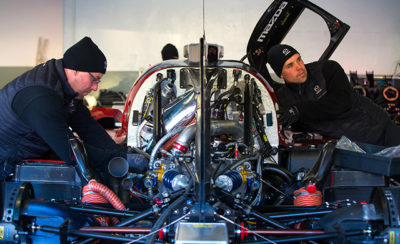Mazda Team Joest has been working hard and making great strides with the prototype race car
The Mazda RT24-P wowed crowds when it was introduced at the LA Auto Show in the fall of 2016. Early attempts in 2017 to put the car on top in a field of top-tier race cars and teams were met with challenges, but never one to shy away from a challenge Mazda doubled down on its efforts and partnered with one of the premier endurance sports car racing outfits to manage the program for the 2018 IMSA season: 15-time 24 Hours of Le Mans winner Team Joest. Early results have shown the RT24-P to be an outright contender, as illustrated by both Mazdas leading at various stages at the 12 Hours of Sebring, and even racing with a shot at victory in the closing stages.
“Obviously there were some issues that the car had from the beginning of last year,” explains Ralf Jüttner, Managing Director of Mazda Team Joest. “One of them – the biggest problem I think – has been the temperature. [The car] was running too hot in terms of cooling; it was running too hot in terms of charge air. Everything was at…the limit. It couldn’t be run to its real possibilities and capabilities because temperatures wouldn’t allow it.”
Running a 2.0-liter turbo engine, the smallest in the IMSA WeatherTech SportsCar Championship Daytona Prototype international field, the team needs to get everything they can out of the engine to be competitive. They also need to make sure it’s propelling as little mass as possible.
“The other big thing is the car was overweight, and that’s pure performance. Every kilo you have to carry around a racetrack is time lost,” says Jüttner.
Working with chassis builder Multimatic, engine partner AER and Mazda, Mazda Team Joest sat down to solve these problems and others. “It was probably the biggest collaboration I’ve been a part of,” says John Doonan, Director of Motorsports at Mazda North American Operations. “We started off with a difficult Daytona, but instantly everyone got back in a room and talked about the issues we faced and came up with countermeasures. Everyone is in the same room, even if you’re part of the engine program and there was a suspension component failure, we all still need to be part of the discussion. I think what you saw at Sebring was a result of that meeting post-Daytona.”
During the off-season, Multimatic developed stiffer rear uprights, which led to new rear suspension, all while addressing the weight and cooling. Mazda Team Joest now has to add ballast back into the car to meet the series dictated minimum weight, and Jüttner says the cooling is spot on. This allows the team to move onto the details.
“Something that needed improvement is the handling of the car,” says Jüttner, speaking not of the way the car brakes and turns, but rather how easy it is to work on. “What does it mean if you change an engine, and how quickly can you do it? How easily can you dismantle the car? Our experience is that the easier that is, it’s not just that the guys spend less time at the racetrack over the night, it’s that what you can disassemble quickly, you disassemble; and what you disassemble, you can control. You see if something is going wrong, and it’s not buried inside where you can’t access it. That’s one of the philosophies we’ve always had, and that’s something we’ve tried to implement into that car. That’s a process that’s ongoing.”
Mazda Team Joest has its next opportunity to test the improvements to the RT24-P against the best that its competitors have to offer at Mid-Ohio Sports Car Course on May 4-6.


 ACCESSIBILITY
ACCESSIBILITY